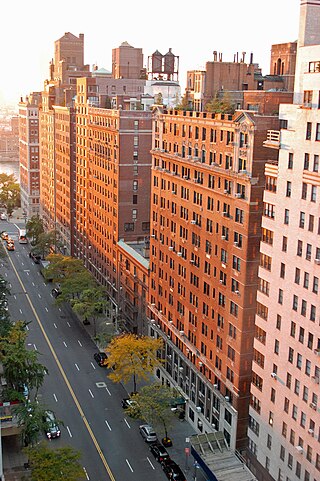
Theodore Roosevelt Jr., often referred to as Teddy or by his initials, T. R., was an American politician, statesman, soldier, conservationist, naturalist, historian, and writer who served as the 26th president of the United States from 1901 to 1909. He previously served as the 25th vice president under President William McKinley from March to September 1901 and as the 33rd governor of New York from 1899 to 1900. Assuming the presidency after McKinley's assassination, Roosevelt emerged as a leader of the Republican Party and became a driving force for anti-trust and Progressive policies.

Duchesne is a city in and the county seat of Duchesne County, Utah, United States. The population was 1,588 at the 2020 census.

The American Museum of Natural History is a natural history museum on the Upper West Side of Manhattan in New York City. Located in Theodore Roosevelt Park, across the street from Central Park, the museum complex comprises 20 interconnected buildings housing 45 permanent exhibition halls, in addition to a planetarium and a library. The museum collections contain about 35 million specimens of plants, animals, fungi, fossils, minerals, rocks, meteorites, human remains, and human cultural artifacts, as well as specialized collections for frozen tissue and genomic and astrophysical data, of which only a small fraction can be displayed at any given time. The museum occupies more than 2,500,000 sq ft (232,258 m2). AMNH has a full-time scientific staff of 225, sponsors over 120 special field expeditions each year, and averages about five million visits annually.

Roosevelt is a neighborhood in north Seattle, Washington. Its main thoroughfare, originally 10th Avenue, was renamed Roosevelt Way upon Theodore Roosevelt's death in 1919. The neighborhood received the name as the result of a Community Club contest held eight years later, in 1927.

Sagamore Hill was the home of the 26th president of the United States, Theodore Roosevelt, from 1885 until his death in 1919. It is located in Cove Neck, New York, near Oyster Bay on the North Shore of Long Island, 25 miles (40 km) east of Manhattan. It is now the Sagamore Hill National Historic Site, which includes the Theodore Roosevelt Museum in a later building on the grounds.

Theodore Roosevelt National Park is an American national park of the badlands in western North Dakota comprising three geographically separated areas. Honoring U.S. President Theodore Roosevelt, it is the only American national park named directly after a single person.

Forsyth Street runs from Houston Street south to Henry Street in the New York City borough of Manhattan. The street was named in 1817 for Lt. Colonel Benjamin Forsyth.

Alexander Phimister Proctor was an American sculptor with the contemporary reputation as one of the nation's foremost animaliers.

The Soldiers' and Sailors' Memorial Monument is a monument located at 89th Street and Riverside Drive in Riverside Park in the Upper West Side of Manhattan, New York City. It commemorates Union Army soldiers and sailors who served in the American Civil War. It is an enlarged version of the Choragic Monument of Lysicrates in Athens, and was designed by the firm of Stoughton & Stoughton with Paul E. M. DuBoy. The monument was completed in 1902.
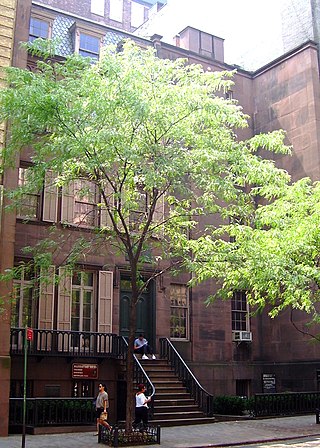
Theodore Roosevelt Birthplace National Historic Site is a recreated brownstone at 28 East 20th Street, between Broadway and Park Avenue South, in the Flatiron District of Manhattan, New York City. It is a replica of the birthplace and childhood home of 26th president of the United States, Theodore Roosevelt.

Stanton Street is a west-to-east street in the New York City borough of Manhattan, in the neighborhood of the Lower East Side. The street begins at the Bowery in the west and runs east to a dead end past Pitt Street, adjacent to Hamilton Fish Park. A shorter section of Stanton Street also exists east of Columbia Street; it was isolated from the remainder of the street in 1959 with the construction of the Gompers Houses and the Masaryk Towers.
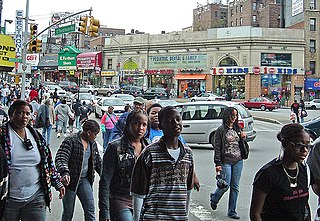
Fordham Road is a major thoroughfare in the Bronx, New York City, that runs west-east from the Harlem River to Bronx Park. Fordham Road houses the borough's largest and most diverse shopping district. It geographically separates the geopolitical North Bronx from the South Bronx.
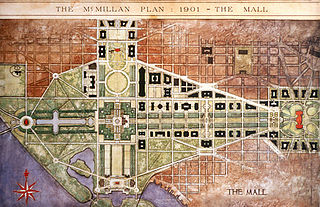
The McMillan Plan is a comprehensive planning document for the development of the monumental core and the park system of Washington, D.C., the capital of the United States. It was written in 1902 by the Senate Park Commission. The commission is popularly known as the McMillan Commission after its chairman, Senator James McMillan of Michigan.
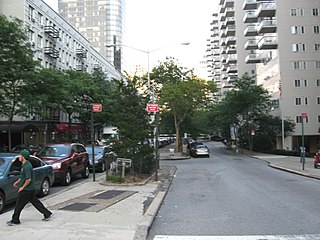
66th Street is a crosstown street in the New York City borough of Manhattan with portions on the Upper East Side and Upper West Side connected across Central Park via the 66th Street transverse. West 66th Street is notable for hosting the Lincoln Center for the Performing Arts between Broadway and Columbus Avenue.

East Side of Manhattan refers to the side of Manhattan which abuts the East River and faces Brooklyn and Queens. Fifth Avenue, Central Park from 59th to 110th Streets, and Broadway below 8th Street separate it from the West Side.
Theodore Roosevelt spent his first summer in Oyster Bay with his family in 1874. Through the ensuing years as he rose to power, Oyster Bay would frequently serve as backdrop and stage on which many of his ambitions were realized. Several places connected to Theodore Roosevelt in his lifetime remain, while others have been lost. A number of efforts to memorialize Roosevelt in Oyster Bay have been made since his death in 1919.
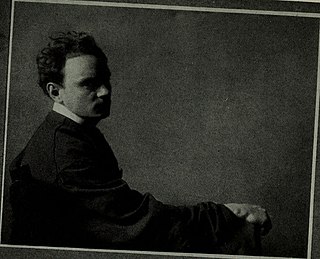
Leo Lentelli was an Italian sculptor who immigrated to the United States. During his 52 years in the United States he created works throughout the country, notably in New York and San Francisco. He also taught sculpture.

Equestrian Statue of Theodore Roosevelt is a 1939 bronze sculpture by James Earle Fraser. It was located on public park land at the American Museum of Natural History in New York City. The equestrian statue depicts Theodore Roosevelt on horseback. Walking on either side of him are two men, on one side a Native American and on the other, a sub-Saharan African.

















